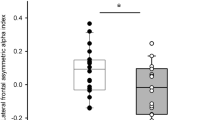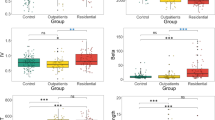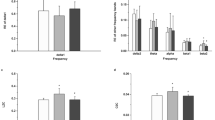Abstract
Hypersomnolence is a common and debilitating symptom in mood disorders. However, objective differentiation of excessive daytime sleepiness (EDS) from non-EDS in depression has not yet been achieved. This study compared performance on the Compensatory Tracking Task (CTT) and concurrently recorded high-density (hd)EEG theta power in 22 patients with major depressive disorder (MDD) and co-occurring EDS against 22 age- and sex-matched patients with MDD but no EDS, as well as 22 age- and sex-matched healthy controls. Though depressed hypersomnolent participants endorsed feeling sleepier than depressed non-hypersomnolent and healthy control participants prior to starting the CTT, no group differences in CTT performance were observed. Average hdEEG theta power was higher during periods of high error on the CTT compared to periods of low error, but did not differ between the groups. Though the CTT still holds promise as an objective neurobehavioral measure, these results do not indicate a capability to differentiate EDS from non-EDS in mood disorders.


Similar content being viewed by others
References
Åkerstedt T, Gillberg M. Subjective and objective sleepiness in the active individual. Int J Neurosci. 1990;52(1–2):29–37. https://doi.org/10.3109/00207459008994241.
Beck AT, Steer RA, Brown GK. Beck depression inventory-II. San Antonio: Psychological Corporation; 1996.
Breslau N, Roth T, Rosenthal L, Andreski P. Sleep disturbance and psychiatric disorders: a longitudinal epidemiological study of young adults. Biol Psychiatry. 1996;39(6):411–8.
Cajochen C, Brunner DP, Kräuchi K, Graw P, Wirz-Justice A. Power density in theta/alpha frequencies of the waking EEG progressively increases during sustained wakefulness. Sleep. 1995;18(10):890–4.
Cajochen C, Khalsa SB, Wyatt JK, Czeisler CA, Dijk DJ. EEG and ocular correlates of circadian melatonin phase and human performance decrements during sleep loss. Am J Physiol. 1999;277(3 Pt 2):R640–9.
Carskadon MA, Dement WC. Effects of total sleep loss on sleep tendency. Percept Mot Skills. 1979;48(2):495–506. https://doi.org/10.2466/pms.1979.48.2.495.
Carskadon MA, Dement WC. Sleep tendency: an objective measure of sleep loss. Sleep Res. 1977;6(200):940.
Chua EC-P, Yeo S-C, Lee IT-G, Tan L-C, Lau P, Cai S, Gooley JJ. Sustained attention performance during sleep deprivation associates with instability in behavior and physiologic measures at baseline. Sleep. 2014;37(1):27–39. https://doi.org/10.5665/sleep.3302.
De Gennaro L, Marzano C, Veniero D, Moroni F, Fratello F, Curcio G, Rossini PM. Neurophysiological correlates of sleepiness: a combined TMS and EEG study. NeuroImage. 2007;36(4):1277–87. https://doi.org/10.1016/j.neuroimage.2007.04.013.
Dinges DF, Powell JW. Microcomputer analyses of performance on a portable, simple visual RT task during sustained operations. Behav Res Methods Instrum Comput. 1985;17(6):652–5.
Farrin L, Hull L, Unwin C, Wykes T, David A. Effects of depressed mood on objective and subjective measures of attention. J Neuropsychiatry Clin Neurosci. 2003;15(1):98–104. https://doi.org/10.1176/jnp.15.1.98.
Findley L, Unverzagt M, Guchu R, Fabrizio M, Buckner J, Suratt P. Vigilance and automobile accidents in patients with sleep apnea or narcolepsy. Chest. 1995;108(3):619–24.
First MB, Spitzer R, Gibbon M, Williams JBW. Structured clinical interview for DSM-IV-TR axis I disorders, research version, patient edition (SCID-I/P). New York: Biometrics Research, New York State Psychiatric Institute; 2002.
Fitzgerald CT, Messias E, Buysse DJ. Teen sleep and suicidality: results from the youth risk behavior surveys of 2007 and 2009. J Clin Sleep Med (JCSM). 2011;7(4):351–6. https://doi.org/10.5664/JCSM.1188.
Fried EI, Nesse RM. The impact of individual depressive symptoms on impairment of psychosocial functioning. PLoS ONE. 2014;9(2):e90311. https://doi.org/10.1371/journal.pone.0090311.
Hawkins DR, Taub JM, Van de Castle RL. Extended sleep (hypersomnia) in young depressed patients. Am J Psychiatry. 1985;142(8):905–10. https://doi.org/10.1176/ajp.142.8.905.
Huang R-S, Jung T-P, Delorme A, Makeig S. Tonic and phasic electroencephalographic dynamics during continuous compensatory tracking. NeuroImage. 2008;39(4):1896–909. https://doi.org/10.1016/j.neuroimage.2007.10.036.
Huang R-S, Jung T-P, Makeig S. Analyzing event-related brain dynamics in continuous compensatory tracking tasks. Annu Int Conf IEEE Eng Med Biol Soc. 2005;6:5750–3. https://doi.org/10.1109/IEMBS.2005.1615794.
Huber R, Mäki H, Rosanova M, Casarotto S, Canali P, Casali AG, Massimini M. Human cortical excitability increases with time awake. Cereb Cortex (New York, N.Y.: 1991). 2013;23(2):332–8. https://doi.org/10.1093/cercor/bhs014.
Hulse BK, Landsness EC, Sarasso S, Ferrarelli F, Guokas JJ, Wanger T, Tononi G. A postsleep decline in auditory evoked potential amplitude reflects sleep homeostasis. Clin Neurophysiol. 2011;122(8):1549–55. https://doi.org/10.1016/j.clinph.2011.01.041.
Hung C-S, Sarasso S, Ferrarelli F, Riedner B, Ghilardi MF, Cirelli C, Tononi G. Local experience-dependent changes in the wake EEG after prolonged wakefulness. Sleep. 2013;36(1):59–72. https://doi.org/10.5665/sleep.2302.
Jaussent I, Bouyer J, Ancelin M-L, Akbaraly T, Pérès K, Ritchie K, Dauvilliers Y. Insomnia and daytime sleepiness are risk factors for depressive symptoms in the elderly. Sleep. 2011;34(8):1103–10. https://doi.org/10.5665/SLEEP.1170.
Johns MW. A new method for measuring daytime sleepiness: the Epworth sleepiness scale. Sleep. 1991;14(6):540–5.
Johns MW. Reliability and factor analysis of the Epworth Sleepiness Scale. Sleep. 1992;15(4):376–81.
Kaplan KA, Plante DT, Cook JD, Soehner AM, Harvey AG. Validation of the Hypersomnia Severity Index (HSI). In: Presented at the Sleep: the 29th annual meeting of the associated professional sleep societies, Seattle; 2015.
Kaplan Katherine A, Gruber J, Eidelman P, Talbot LS, Harvey AG. Hypersomnia in inter-episode bipolar disorder: does it have prognostic significance? J Affect Disord. 2011;132(3):438–44. https://doi.org/10.1016/j.jad.2011.03.013.
Kofmel NC, Schmitt WJ, Hess CW, Gugger M, Mathis J. Sleepiness and performance is disproportionate in patients with non-organic hypersomnia in comparison to patients with narcolepsy and mild to moderate obstructive sleep apnoea. Neuropsychobiology. 2014;70(3):189–94. https://doi.org/10.1159/000365486.
Lim J, Dinges DF. Sleep deprivation and vigilant attention. Ann N Y Acad Sci. 2008;1129:305–22. https://doi.org/10.1196/annals.1417.002.
Littner MR, Kushida C, Wise M, Davila DG, Morgenthaler T, Lee-Chiong T, Standards of Practice Committee of the American Academy of Sleep Medicine. Practice parameters for clinical use of the multiple sleep latency test and the maintenance of wakefulness test. Sleep. 2005;28(1):113–21.
Lopez R, Doukkali A, Barateau L, Evangelista E, Chenini S, Jaussent I, Dauvilliers Y. Test–retest reliability of the multiple sleep latency test in central disorders of hypersomnolence. Sleep. 2017;40(12):164. https://doi.org/10.1093/sleep/zsx164.
Makeig S, Jung TP, Bell AJ, Ghahremani D, Sejnowski TJ. Blind separation of auditory event-related brain responses into independent components. Proc Natl Acad Sci USA. 1997;94(20):10979–84.
Makeig S, Jung TP, Sejnowski TJ. Awareness during drowsiness: dynamics and electrophysiological correlates. Can J Exp Psychol (Revue Can Psychol Exp). 2000;54(4):266–73.
Mensen A, Khatami R. Advanced EEG analysis using threshold-free cluster-enhancement and non-parametric statistics. NeuroImage. 2013;67:111–8. https://doi.org/10.1016/j.neuroimage.2012.10.027.
Ohayon MM, Dauvilliers Y, Reynolds CF III. Operational definitions and algorithms for excessive sleepiness in the general population: implications for DSM-5 nosology. Arch Gen Psychiatry. 2012;69(1):71. https://doi.org/10.1001/archgenpsychiatry.2011.1240.
Plante DT. Sleep propensity in psychiatric hypersomnolence: a systematic review and meta-analysis of multiple sleep latency test findings. Sleep Med Rev. 2017;31:48–57. https://doi.org/10.1016/j.smrv.2016.01.004.
Plante DT, Cook JD, Barbosa LS, Goldstein MR, Prairie ML, Smith RF, Riedner BA. Establishing the objective sleep phenotype in hypersomnolence disorder with and without comorbid major depression. Sleep. 2019. https://doi.org/10.1093/sleep/zsz060 (in press).
Plante DT, Finn LA, Hagen EW, Mignot E, Peppard PE. Subjective and objective measures of hypersomnolence demonstrate divergent associations with depression among participants in the Wisconsin Sleep Cohort Study. J Clin Sleep Med (JCSM). 2016;12(4):571–8. https://doi.org/10.5664/jcsm.5694.
Poudel GR, Innes CR, Bones PJ, Jones RD. The relationship between behavioural microsleeps, visuomotor performance and EEG theta. In: 2010 annual international conference of the IEEE Engineering in Medicine and Biology Society (EMBC). New York: IEEE; 2010. p. 4452–4455.
Roberts RE, Shema SJ, Kaplan GA, Strawbridge WJ. Sleep complaints and depression in an aging cohort: a prospective perspective. Am J Psychiatry. 2000;157(1):81–8.
Robertson IH, Manly T, Andrade J, Baddeley BT, Yiend J. “Oops!”: performance correlates of everyday attentional failures in traumatic brain injured and normal subjects. Neuropsychologia. 1997;35(6):747–58.
Rye DB, Bliwise DL, Parker K, Trotti LM, Saini P, Fairley J, Freeman A, Garcia PS, Owens MJ, Ritchie JC, Jenkins A. Modulation of vigilance in the primary hypersomnias by endogenous enhancement of GABAA receptors. Sci Transl Med. 2012;4(161):161ra151. https://doi.org/10.1126/scitranslmed.3004685.
Sakurai H, Uchida H, Abe T, Nakajima S, Suzuki T, Pollock BG, Mimura M. Trajectories of individual symptoms in remitters versus non-remitters with depression. J Affect Disord. 2013;151(2):506–13. https://doi.org/10.1016/j.jad.2013.06.035.
Soehner AM, Kaplan KA, Harvey AG. Prevalence and clinical correlates of co-occurring insomnia and hypersomnia symptoms in depression. J Affect Disord. 2014;167:93–7. https://doi.org/10.1016/j.jad.2014.05.060.
Strijkstra AM, Beersma DGM, Drayer B, Halbesma N, Daan S. Subjective sleepiness correlates negatively with global alpha (8–12 Hz) and positively with central frontal theta (4–8 Hz) frequencies in the human resting awake electroencephalogram. Neurosci Lett. 2003;340(1):17–20.
Thomann J, Baumann CR, Landolt H-P, Werth E. Psychomotor vigilance task demonstrates impaired vigilance in disorders with excessive daytime sleepiness. J Clin Sleep Med (JCSM). 2014;10(9):1019–24. https://doi.org/10.5664/jcsm.4042.
Trotti LM. Characterizing sleepiness: are we drawing the right line in the sand? J Clin Sleep Med (JCSM). 2017;13(12):1369–70. https://doi.org/10.5664/jcsm.6824.
Van Schie MKM, Thijs RD, Fronczek R, Middelkoop HAM, Lammers GJ, Van Dijk JG. Sustained attention to response task (SART) shows impaired vigilance in a spectrum of disorders of excessive daytime sleepiness. J Sleep Res. 2012;21(4):390–5. https://doi.org/10.1111/j.1365-2869.2011.00979.x.
Worthington J, Fava M, Davidson K, Alpert J, Nierenberg AA, Rosenbaum JF. Patterns of improvement in depressive symptoms with fluoxetine treatment. Psychopharmacol Bull. 1995;31(2):223–6.
Funding
This study was funded by the National Institutes of Health (K23MH099234). It was also supported by grants from the American Sleep Medicine Foundation (76-JF-12) and Brain and Behavior Research Foundation (19193).
Author information
Authors and Affiliations
Corresponding author
Ethics declarations
Conflict of interest
Emily C. Forscher declares that she/he has no conflict of interest. Michael L. Prairie declares that she/he has no conflict of interest. Jesse D. Cook declares that she/he has no conflict of interest. Sydney L. Notermann declares that she/he has no conflict of interest. David T. Plante has received royalties from Cambridge University Press and has served as a consultant for Teva Pharmaceuticals Australia and Jazz Pharmaceuticals.
Ethical approval
All procedures performed in studies involving human participants were in accordance with the ethical standards of the institutional and/or national research committee and with the 1964 Helsinki declaration and its later amendments or comparable ethical standards.
Informed consent
Informed consent was obtained from all individual participants included in the study.
Additional information
Publisher's Note
Springer Nature remains neutral with regard to jurisdictional claims in published maps and institutional affiliations.
Rights and permissions
About this article
Cite this article
Forscher, E.C., Prairie, M.L., Cook, J.D. et al. Utility of the Compensatory Tracking Task for Objective Differentiation of Hypersomnolence in Depression: A High-Density EEG Investigation. Sleep Vigilance 3, 49–56 (2019). https://doi.org/10.1007/s41782-019-00062-8
Received:
Revised:
Accepted:
Published:
Issue Date:
DOI: https://doi.org/10.1007/s41782-019-00062-8




